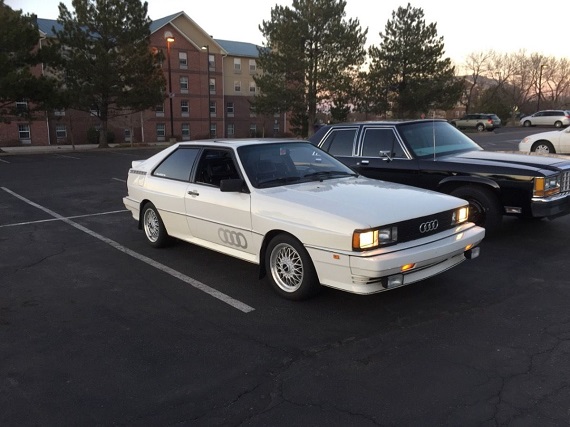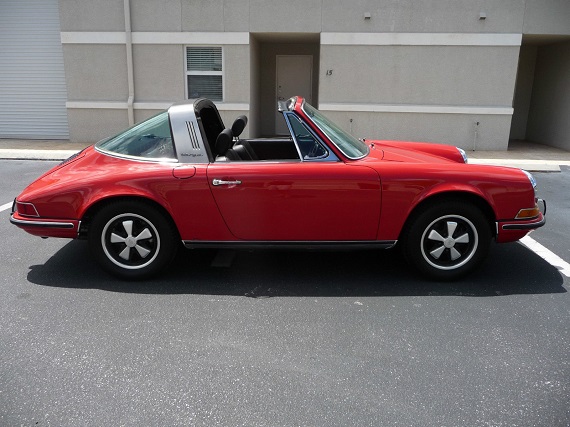It’s a sigh of relief to see a market correction in classic Audi’s favor. For such a long time, Audis were simply unappreciated; but innovative designs, great looks and solid build quality mean that those who hung on for the depreciation ride are now smiling a bit more. There’s simply more appreciation for the classic Audis now then perhaps ever; even perhaps more than when they were new. That’s because back then, no one knew what they were, really – but today, the legend of Quattro has spread and thanks to the proliferation of internet video, we still get to hear the raucous barking and watch the belching flames from the turbocharged inline-5. This past weekend, I took my Coupe GT out for a ride. I grabbed my cousin and we went to look at a new car for him; a 2009 Subaru WRX. Much like a modern interpretation of the original Audis, it’s apropos that we arrived in an Audi to take a look at it. What was perhaps more striking, though, was the reaction of the Subaru crowd. We showed up to a Subaru speed shop where the WRX was to be view, and instantly once within earshot, all of the crew at the garage came out to see the approaching Audi. It was a genuine show of respect, smiles, and thumbs up from a crew you wouldn’t automatically assume would know their history. Even more shocking, though, was the resounding appreciation they showed for the old car – more than often is seen at Audi-specific events. That’s the legend and the importance of the Quattro:
Month: April 2015
I feel somewhat remiss in never featuring one of the long-hood Targas during convertible week last week. While not really a true convertible they were the only open-top option for the 911 during that time period. For full effect you’d want the Soft-window Targa, but frankly the hard-window Targa is a much better looking car and still provides much of the open feel that makes any convertible so prized in the first place. So I’ll try to fill that gap with this Bahia Red 1972 Porsche 911T Targa, located in Florida, with a reported 53,294 miles on it. This Targa sat for a while and was given a basic refreshing of much of the mechanical components prior to being put up for sale, but the paint and interior are original to the car. Because this is a 1972 MY 911 that makes it an oil flapper, meaning it was fitted with an external oil filler located on the rear quarter panel. Porsche had hoped to improve weight distribution by moving the oil reservoir inside the wheelbase, but ultimately reverted to the original design one year later out of concern for people who mistook it for the gas tank and added fuel to their oil. Regardless, the 1972 cars are the only ones to possess this unique feature.
CLICK FOR DETAILS: 1972 Porsche 911T Targa on eBay
1 CommentAs I’ve written up a steady stream of Porsches and BMWs of late I thought it prudent to mix it up as I’d hate to get automotive tunnel vision. I had just finished editing some pictures of my girlfriend’s new MkVII Golf when it dawned on me that perhaps one of its early ancestors would make for an interesting post. With that in mind I set about scouring the depths of the internet in hopes of finding something quirky that would spark my interest. I’ve never been a rabid VW fanboy but my New England upbringing did instill a healthy appreciation for Das Auto. In my adolescence I probably spent more time in MkIII Jettas than any other car. A few friends had Golfs but for whatever reason those were far less popular in my neck of the woods. I like an underdog so I focused my search on old Golfs, passing over a number of listings for modified Jettas.
Personally I’ve always preferred the practicality of the hatchback design especially since the Golf was the base for the GTI, which with the exception of the MkIV & MkV, is a nameplate I am a fan of.  I think part of what I love about those older boxier designs is that they do not look fast, not even with a bunch of modifications. They are spartan, basic and from a design standpoint relatively un-inspired but that’s exactly what I think makes them cool. If older GTIs don’t ask for attention then the MkI Rabbit is the hermit of the VW family, living way out in the woods with no internet, phone or electricity. So when I came across a clean ’81 Rabbit hiding a 2.0L 16v EA827 under its hood, I knew I had to post it.
And now for something completely different.
CLICK FOR DETAILS:Â 1981 Volkswagen Rabbit on VWVortex
6 CommentsIn case you haven’t noticed, we like Swedish cars here at GCFSB. They embody a lot of the sturdy, well-engineered qualities as the cars from Germany possess. Perhaps one of the most Germanic of all Swedish machines was the Volvo 240 series. Known in some circles as “the brick,” these cars lasted in production for 21 years, all the way to the early 1990s. Many of these cars are still on the road today and beloved by their owners. This 242 for sale in New York is quite possibly the best preserved example of a two-door model I’ve ever seen.
CLICK FOR DETAILS: 1978 Volvo 242 on eBay
2 CommentsIt’s time to take a moment to visit one of the enduring performance values in not only the Porsche market, but in the second-hand market in general. Just about any 911 Turbo is a hallowed performance machine that can compete with a wide variety of high-dollar supercars, yet still provide a refined driving environment for the owner seeking a relaxed cruise. That refinement wasn’t always the case with the Turbo, but Porsche’s goal has always been to showcase both sides of its engineering acumen with these cars and ever since the 993TT it has excelled in that department. Of all of the extant models the 996TT remains the least loved. The first to have a water-cooled engine combined with a somewhat wonky appearance will do that, but the performance has never really been the issue. So while the model itself loses out on the market, buyers win. Here we have a Guards Red 2001 Porsche 911 Turbo, located in Texas, with a pretty reasonable 35,924 miles on it and a 6-speed manual transmission.






